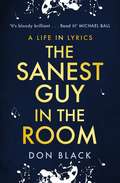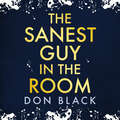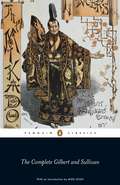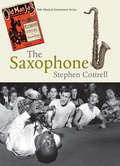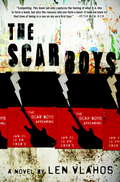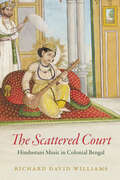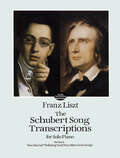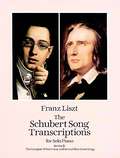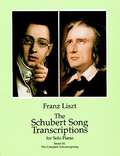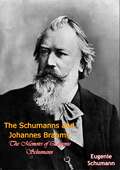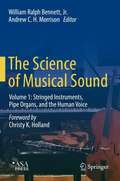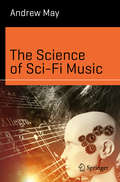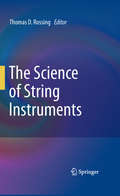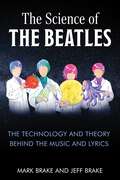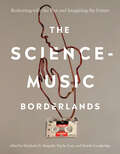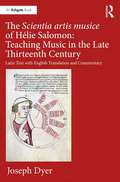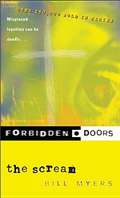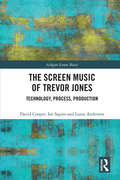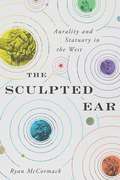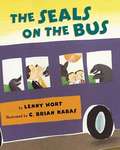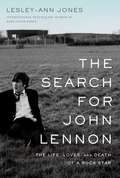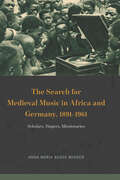- Table View
- List View
The San Francisco Symphony: Music, Maestros and Musicians
by David Schneider Edo De WaartA guide to the last 50 years of music in San Francisco.
The Sanest Guy in the Room: A Life in Lyrics
by Don BlackTHE SUNDAY TIMES BESTSELLER'. . . a compelling memoir. Breezy and unpretentious, The Sanest Guy in the Room is a delightful collection of memories, insider information and after-dinner anecdotes' The Times'Brilliant stories and wonderful behind-the-scenes glimpses of a life and career in show-business . . . It's bloody brilliant . . . Read it!' Michael BallDon Black is the songwriter's songwriter, a composer's dream collaborator, and the man behind some of the twentieth century's greatest musical numbers.Black made his first foray into the glittering world of showbiz as a stand-up, before realising his error and focusing on his lifelong passion instead - music. Shirley Bassey, Michael Jackson, Quincy Jones, Henry Mancini and Barbra Streisand are just some of the artists Black has worked with over the years - not to mention his frequent collaborator, West End legend Andrew Lloyd Webber - in what can only be described as a remarkable musical career. Yet, never one to court fame, Black has always remained what Mark Steyn coined as 'the sanest guy in the room'.Interwoven with the stories behind songs such as 'Diamonds are Forever' and 'Born Free' are vignettes of Black's life with his beloved wife Shirley, who died in March 2018, after almost sixty years of marriage. Black writes movingly about how the enormity of his grief changed his life, and how the dark days are slowly turning into dark moments.The Sanest Guy in the Room is a rich and delightful paean to a life lived through song. It reveals the essence of Black's craft, looks at those who have inspired him and allows us to understand what made those icons tick. It is also a poignant tribute to Shirley, his biggest inspiration. Told with wit, warmth and great humour, this is Don Black's astonishing musical journey and an insight into a life behind the lyrics.
The Sanest Guy in the Room: A Life in Lyrics
by Don BlackTHE SUNDAY TIMES BESTSELLER'. . . a compelling memoir. Breezy and unpretentious, The Sanest Guy in the Room is a delightful collection of memories, insider information and after-dinner anecdotes' The Times'Brilliant stories and wonderful behind-the-scenes glimpses of a life and career in show-business . . . It's bloody brilliant . . . Read it!' Michael BallDon Black is the songwriter's songwriter, a composer's dream collaborator, and the man behind some of the twentieth century's greatest musical numbers.Black made his first foray into the glittering world of showbiz as a stand-up, before realising his error and focusing on his lifelong passion instead - music. Shirley Bassey, Michael Jackson, Quincy Jones, Henry Mancini and Barbra Streisand are just some of the artists Black has worked with over the years - not to mention his frequent collaborator, West End legend Andrew Lloyd Webber - in what can only be described as a remarkable musical career. Yet, never one to court fame, Black has always remained what Mark Steyn coined as 'the sanest guy in the room'.Interwoven with the stories behind songs such as 'Diamonds are Forever' and 'Born Free' are vignettes of Black's life with his beloved wife Shirley, who died in March 2018, after almost sixty years of marriage. Black writes movingly about how the enormity of his grief changed his life, and how the dark days are slowly turning into dark moments.The Sanest Guy in the Room is a rich and delightful paean to a life lived through song. It reveals the essence of Black's craft, looks at those who have inspired him and allows us to understand what made those icons tick. It is also a poignant tribute to Shirley, his biggest inspiration. Told with wit, warmth and great humour, this is Don Black's astonishing musical journey and an insight into a life behind the lyrics.
The Sanest Guy in the Room: A Life in Lyrics
by Don BlackTHE SUNDAY TIMES BESTSELLER'. . . a compelling memoir. Breezy and unpretentious, The Sanest Guy in the Room is a delightful collection of memories, insider information and after-dinner anecdotes' The Times'Brilliant stories and wonderful behind-the-scenes glimpses of a life and career in show-business . . . It's bloody brilliant . . . Read it!' Michael BallDon Black is the songwriter's songwriter, a composer's dream collaborator, and the man behind some of the twentieth century's greatest musical numbers.Black made his first foray into the glittering world of showbiz as a stand-up, before realising his error and focusing on his lifelong passion instead - music. Shirley Bassey, Michael Jackson, Quincy Jones, Henry Mancini and Barbra Streisand are just some of the artists Black has worked with over the years - not to mention his frequent collaborator, West End legend Andrew Lloyd Webber - in what can only be described as a remarkable musical career. Yet, never one to court fame, Black has always remained what Mark Steyn coined as 'the sanest guy in the room'.Interwoven with the stories behind songs such as 'Diamonds are Forever' and 'Born Free' are vignettes of Black's life with his beloved wife Shirley, who died in March 2018, after almost sixty years of marriage. Black writes movingly about how the enormity of his grief changed his life, and how the dark days are slowly turning into dark moments.The Sanest Guy in the Room is a rich and delightful paean to a life lived through song. It reveals the essence of Black's craft, looks at those who have inspired him and allows us to understand what made those icons tick. It is also a poignant tribute to Shirley, his biggest inspiration. Told with wit, warmth and great humour, this is Don Black's astonishing musical journey and an insight into a life behind the lyrics.
The Savoy Operas: The Complete Gilbert and Sullivan
by Arthur Sullivan W. S. GilbertGilbert and Sullivan’s operas are some of the world’s best-loved musical works, delighting audiences with their joyous wit, topsy-turvy logic and extravagant wordplay. This glorious treasury is the definitive annotated edition of all fourteen of their operas. From the partially lost work Thespis, the first collaboration between W. S. Gilbert and Arthur Sullivan, through the triumphant comic romps The Pirates of Penzance and The Mikado, to lesser-performed gems such as the fanciful The Sorcerer and the acerbic lampoon Patience, Gilbert’s libretti are collected here in their most accurate and faithful form. There is a fascinating commentary on each work, telling the extraordinary stories behind the inspiration for the opera and its performance history, and giving plot summaries and original cast lists.
The Saxophone
by Stephen CottrellIn the first fully comprehensive study of one of the world’s most iconic musical instruments, Stephen Cottrell examines the saxophone’s various social, historical, and cultural trajectories, and illustrates how and why this instrument, with its idiosyncratic shape and sound, became important for so many different music-makers around the world. After considering what led inventor Adolphe Sax to develop this new musical wind instrument, Cottrell explores changes in saxophone design since the 1840s, before examining the instrument's role in a variety of contexts: in the military bands that contributed so much to the saxophone's global dissemination during the nineteenth century; as part of the rapid expansion of American popular music around the turn of the twentieth century; in classical and contemporary art music; in world and popular music; and, of course, in jazz, a musical style with which the saxophone has become closely identified.
The Scar Boys
by Len VlahosA severely burned teenager. A guitar. Punk rock. The chords of a rock 'n' roll road trip in a coming-of-age novel that is a must-read story about finding your place in the world...even if you carry scars inside and out. In attempting to describe himself in his college application essay--help us to become acquainted with you beyond your courses, grades, and test scores--Harbinger (Harry) Jones goes way beyond the 250-word limit and gives a full account of his life. The first defining moment: the day the neighborhood goons tied him to a tree during a lightning storm when he was 8 years old, and the tree was struck and caught fire. Harry was badly burned and has had to live with the physical and emotional scars, reactions from strangers, bullying, and loneliness that instantly became his everyday reality. The second defining moment: the day in 8th grade when the handsome, charismatic Johnny rescued him from the bullies and then made the startling suggestion that they start a band together. Harry discovered that playing music transported him out of his nightmare of a world, and he finally had something that compelled people to look beyond his physical appearance. Harry's description of his life in his essay is both humorous and heart-wrenching. He had a steeper road to climb than the average kid, but he ends up learning something about personal power, friendship, first love, and how to fit in the world. While he's looking back at the moments that have shaped his life, most of this story takes place while Harry is in high school and the summer after he graduates.
The Scattered Court: Hindustani Music in Colonial Bengal (Chicago Studies in Ethnomusicology)
by Richard David WilliamsPresents a new history of how Hindustani court music responded to the political transitions of the nineteenth century. How far did colonialism transform north Indian music? In the period between the Mughal empire and the British Raj, how did the political landscape bleed into aesthetics, music, dance, and poetry? Examining musical culture through a diverse and multilingual archive, primarily using sources in Urdu, Bengali, and Hindi that have not been translated or critically examined before, The Scattered Court challenges our assumptions about the period. Richard David Williams presents a long history of interactions between northern India and Bengal, with a core focus on the two courts of Wajid Ali Shah (1822–1887), the last ruler of the kingdom of Awadh. He charts the movement of musicians and dancers between the two courts in Lucknow and Matiyaburj, as well as the transregional circulation of intellectual traditions and musical genres, and demonstrates the importance of the exile period for the rise of Calcutta as a celebrated center of Hindustani classical music. Since Lucknow is associated with late Mughal or Nawabi society and Calcutta with colonial modernity, examining the relationship between the two cities sheds light on forms of continuity and transition over the nineteenth century, as artists and their patrons navigated political ruptures and social transformations. The Scattered Court challenges the existing historiography of Hindustani music and Indian culture under colonialism by arguing that our focus on Anglophone sources and modernizing impulses has directed us away from the aesthetic subtleties, historical continuities, and emotional dimensions of nineteenth-century music.
The Schubert Song Transcriptions for Solo Piano/Series I: "Ave Maria," "Erlkonig" and Ten Other Great Songs (Dover Classical Piano Music)
by Franz LisztIn the course of his long career as the outstanding pianist-composer of his time, Franz Liszt was a tireless champion of music by other composers, especially those whose works he felt deserved greater recognition. Beethoven's symphonies, Wagner's operas, and Schubert's songs were among the compositions Liszt chose to promote by transforming them from their original scoring into new conceptions for solo piano.This volume contains twelve great Schubert lieder in Liszt's brilliant transcriptions, including such well-known masterpieces as "Ave Maria," "Der Wanderer," "Die junge Nonne," "Gretchen am Spinnrade," and the unforgettable "Erlkönig."Reproduced from extremely rare early editions, this unique volume of transcriptions brings to pianists and music lovers the familiar beauty of Schubert's melodies in solo piano arrangements that reflect Liszt's incomparable mastery of the keyboard.
The Schubert Song Transcriptions for Solo Piano/Series II: The Complete Winterreise and Seven Other Great Songs (Dover Classical Piano Music)
by Franz LisztOf the many piano transcriptions Franz Liszt made of the works of other composers, those he made of the songs of Franz Schubert are among his most inspired. This volume contains the legendary pianist's twelve transcriptions from Schubert's great song cycle Winterreise, along with the four songs of Geistliche Lieder and the beloved single songs "La Rose," "Lob der Thränen" and "Die Forelle."These rare transcriptions offer a unique blending of Classical inspiration with Romantic virtuosity. Here, Liszt retained the intense lyricism and emotional impact of Schubert's songs as he transformed them into dazzling compositions for solo piano. For generations, pianists and their audiences savored the rich rewards of Liszt's memorable achievement, even as the long-awaited publication of this Dover volume, nineteen rare gems of the keyboard literature are once more available, reproduced from extremely rare early editions.
The Schubert Song Transcriptions for Solo Piano/Series III: The Complete Schwanengesang (Dover Classical Piano Music)
by Franz LisztThe foremost pianist-composer of his day, Franz Liszt unselfishly promoted the works of his fellow composers through his brilliant piano transcriptions of their music. Among his most inspired contributions to the literature were his legendary transcriptions of Franz Schubert's songs.This volume -- the third and last in Dover's popular series of Liszt-Schubert song transcriptions -- contains Schubert's complete Schwanengesang (Swan Song), including "Abschied," "Am Meer," "Das Fischermädchen," "Ständchen" (the world-famous "Serenade"), "Der Doppelganger," and nine other great lieder.Reproduced from extremely rare early editions edited by Liszt himself, these dazzling transcriptions retain all the lyric beauty and emotional depth of Schubert's original music, yet reflect Liszt's incomparable mastery of the difficult art of transcription from the original medium of voice and piano to that of solo piano. A modestly priced collection of hard-to-find treasures of 19th century literature, these unique facsimile reproductions will be prized by pianists and all lovers of fine music.
The Schumanns and Johannes Brahms: The Memoirs of Eugenie Schumann
by Eugenie SchumannEugenie Schumann, youngest daughter of the famed composer Robert Schumann and his wife Clara discusses her memories of her life, and her studies with Johannes Brahms. Drawing upon correspondences between members of the Schumann family, Eugenie relates her memories of childhood and education, and her experiences learning music under the tutorship of Johannes Brahms. The ongoing fame of her mother Clara Schumann meant the family was consistently under the musical spotlight, the public eager for each new performance and composition. Eugenie's recollections of her siblings are poignant: more than once, we hear of the pressure her siblings were under to meet the achievements of their gifted parents. Despite these stresses, Eugenie places emphasis on her mother's caring and compassionate nature; though the encroaching demands of fame were a fact of the Schumann family life, Clara Schumann is praised for her efforts at keeping the family united.-Print ed.
The Science of Musical Sound: Volume 1: Stringed Instruments, Pipe Organs, and the Human Voice
by William Ralph Bennett Jr. Andrew C. Morrison Christy K. HollandThis textbook is a product of William Bennett’s work in developing and teaching a course on the physics of music at Yale University to a diverse audience of musicians and science students in the same class. The book is a culmination of over a decade of teaching the course and weaves together historical descriptions of the physical phenomena with the author’s clear interpretations of the most important aspects of the science of music and musical instruments. Many of the historical examples are not found in any other textbook available on the market. As the co-inventor of the Helium-Neon laser, Prof. Bennett’s knowledge of physics was world-class. As a professor at one of the most prestigious liberal-arts universities in the world, his appreciation for culture and humanities shines through. The book covers the basics of oscillations, waves and the analysis techniques necessary for understanding how musical instruments work. All types of stringed instruments, pipe organs, and the human voice are covered in this volume. A second volume covers the remaining families of musical instruments as well as selected other topics. Readers without a background in acoustics will enjoy learning the physics of the Science of Musical Sound from a preeminent scientist of the 20th century. Those well versed in acoustics will discover wonderful illustrations and photographs depicting familiar concepts in new and enlightening ways.
The Science of Sci-Fi Music (Science and Fiction)
by Andrew MayThe 20th century saw radical changes in the way serious music is composed and produced, including the advent of electronic instruments and novel compositional methods such as serialism and stochastic music. Unlike previous artistic revolutions, this one took its cues from the world of science. Creating electronic sounds, in the early days, required a well-equipped laboratory and an understanding of acoustic theory. Composition became increasingly “algorithmic”, with many composers embracing the mathematics of set theory. The result was some of the most intellectually challenging music ever written – yet also some of the best known, thanks to its rapid assimilation into sci-fi movies and TV shows, from the electronic scores of Forbidden Planet and Dr Who to the other-worldly sounds of 2001: A Space Odyssey.This book takes a close look at the science behind "science fiction" music, as well as exploring the way sci-fi imagery found its way into the work of musicians like Sun Ra and David Bowie, and how music influenced the science fiction writings of Philip K. Dick and others.
The Science of String Instruments
by Thomas D. RossingThis book will be a non-technical book on string instruments that includes some technical information as well. The emphasis will be on the practical understanding of string instruments, with the interests of performers and instrument builders in the forefront. Authors of the chapters will be musicians, scientists, and instrument designers and builders with practical experience. The mathematics will be kept as simple as possible by translating ideas from the language of physics (mathematics) to non-mathematical language. Considerable emphasis will be placed on the design and construction of string instruments. Following the structure of the author's successful Science of Percussion Instruments (World Scientific, 2000), technical ideas will be presented as "interludes." Readers who wish to go beyond the simple ideas in this book can easily follow the references to more scientific books and to the original scientific literature.
The Science of The Beatles: The Technology and Theory Behind the Music and Lyrics (The Science of)
by Mark Brake Dr. Jeff BrakeAn In-Depth Analysis of The Beatles' Music and the Theory, Techniques, and Technology That Made It Possible When people look back in two hundred years time at our culture, whose music will have survived from today? Who will be our equivalent of Bach, Mozart, and Beethoven? The big story of contemporary popular music has been The Beatles. They were the chief architects of the fusion of classical and popular music to create a new musical mainstream. From the time we humans first made our art, music and technology have been inseparable. And that symbiotic relationship has never been so excitingly orchestrated than with the musical history of The Beatles. They absorbed many other styles around them in an extraordinary and unprecedented melting pot of music. And they embraced new technologies with enthusiasm and imagination. As pioneers of recording tech and artistic presentation, making American music with a British twist, The Beatles revolutionized many aspects of music tech, and became leaders of the era&’s youth and sociocultural movements. Their music was both genuinely sophisticated and hugely popular. For a generation, they were the most important composers in the world, and became the most influential band of all time. Putting the band&’s thirteen legendary studio albums under a microscope, The Science of The Beatles looks at the science, poetry, and raw-power in the music that started a revolution.
The Science-Music Borderlands: Reckoning with the Past and Imagining the Future
by Elizabeth Hellmuth Margulis, Psyche Loui, and Deirdre LoughridgeInterdisciplinary essays on music psychology that integrate scientific, humanistic, and artistic ways of knowing in transformative ways.Researchers using scientific methods and approaches to advance our understanding of music and musicality have not yet grappled with some of the perils that humanistic fields concentrating on music have long articulated. In this edited volume, established and emerging researchers—neuroscientists and cognitive scientists, musicians, historical musicologists, and ethnomusicologists—build bridges between humanistic and scientific approaches to music studies, particularly music psychology. Deftly edited by Elizabeth H. Margulis, Psyche Loui, and Deirdre Loughridge, The Science-Music Borderlands embodies how sustained interaction among disciplines can lead to a richer understanding of musical life.The essays in this volume provide the scientific study of music with its first major reckoning, exploring the intellectual history of the field and its central debates, while charting a path forward.The Science-Music Borderlands is essential reading for music scholars from any disciplinary background. It will also interest those working at the intersection of music and science, such as music teachers, performers, composers, and music therapists.Contributors:Manuel Anglada-Tort, Salwa El-Sawan Castelo-Branco, Hu Chuan-Peng, Laura K. Cirelli, Alexander W. Cowan, Jonathan De Souza, Diana Deutsch, Diandra Duengen, Sarah Faber, Steven Feld, Shinya Fujii, Assal Habibi, Erin. E. Hannon, Shantala Hegde, Beatriz Ilari, Jason Jabbour, Nori Jacoby, Haley E. Kragness, Grace Leslie, Casey Lew-Williams, Deirdre Loughridge, Psyche Loui, Diana Mangalagiu, Elizabeth H. Margulis, Randy McIntosh, Rita McNamara, Eduardo Reck Miranda, Daniel Müllensiefen, Rachel Mundy, Florence Ewomazino Nweke, Patricia Opondo, Aniruddh D. Patel, Andrea Ravignani, Carmel Raz, Matthew Sachs, Marianne Sarfati, Patrick E. Savage, Huib Schippers, Jim Sykes, Gary Tomlinson, Jamal Williams, Maria A. G. Witek, Pamela Z
The Scientia artis musice of Hélie Salomon: Latin Text with English Translation and Commentary
by Joseph DyerHélie Salomon’s Scientia artis musice (1274), is a practical manual devoted to basic concepts, psalmody, vocal pedagogy, the musical hand in singing, clefs as indicators of the tone (mode) to which a piece belongs, and practical instruction in the singing of four-voice parallel organum. Joseph Dyer presents the first, much-needed, modern edition of Salomon’s treatise, accompanied by a full English translation, comprehensive introduction and commentary. This edition corrects errors in the 1784 edition of Martin Gerbert, includes the music of chants omitted by Gerbert from the tonary, and makes available reproductions in colour of the eight illustrations in the treatise.
The Scream (Forbidden Doors, #9)
by Bill Myers"He has no concept of the danger he's in." Rebecca Williams is about to learn this first hand. She and her brother, Scott, are going to L.A. to the hottest concert in the country. What could be better than that? Rebecca knows she should be excited, but since she read Z's e-mail all she feels is apprehension. They've been asked to help the drummer for The Scream, the nation's top rock band. Rebecca has faced danger before -- so why does this assignment have her so on edge? Join Becka and Scott as they learn valuable truths about the lure of the supernatural, the reality of spiritual warfare -- and the truth of victory in Jesus. Ouija boards, witchcraft, voodoo, vampires and more are covered in these edge-of-your-seat thrillers for teens. Recommended for ages 12 and up.
The Screen Music of Trevor Jones: Technology, Process, Production (Ashgate Screen Music Series)
by David Cooper Laura Anderson Ian SapiroThe first significant publication devoted entirely to Trevor Jones’s work, The Screen Music of Trevor Jones: Technology, Process, Production, investigates the key phases of his career within the context of developments in the British and global screen-music industries. This book draws on the direct testimony of the composer and members of his team as well as making use of the full range of archival materials held in the University of Leeds’s unique Trevor Jones Archive, which was digitized with support from the Arts and Humanities Research Council. Through a comprehensive series of chapters covering Jones’s early career to his recent projects, this book demonstrates how Jones has been active in an industry that has experienced a prolonged period of major technological change, including the switchover from analogue to digital production and post-production techniques, and developments in computer software for score production and sound recording/editing. This is a valuable study for scholars, researchers and professionals in the areas of film music, film-score production and audio-visual media.
The Sculpted Ear: Aurality and Statuary in the West (Perspectives on Sensory History #2)
by Ryan McCormackSound and statuary have had a complicated relationship in Western aesthetic thought since antiquity. Taking as its focus the sounding statue—a type of anthropocentric statue that invites the viewer to imagine sounds the statue might make—Sculpted Ears rethinks this relationship in light of discourses on aurality emerging within the field of sound studies. Ryan McCormack argues that the sounding statue is best thought of not as an aesthetic object but as an event heard by people and subsequently conceptualized into being through acts of writing and performance.Constructing a history in which hearing plays an integral role in ideas about anthropocentric statuary, McCormack begins with the ancient sculpture of Laocoön, before moving to a discussion of the early modern automaton known as Tipu’s Tiger and the statue of the Commendatore in Mozart’s Don Giovanni. Finally, he examines statues of people from the present and the past, including the singer Josephine Baker, the violinist Aleksandar Nikolov, and the actor Bob Newhart—with each case touching on some of the issues that have historically plagued the aesthetic viability of the sounding statue. McCormack convincingly demonstrates how sounding statues served as important precursors and continuing contributors to modern ideas about the ontology of sound, technologies of sound reproduction, and performance practices blurring traditional divides between music, sculpture, and the other arts.A compelling narrative that illuminates the stories of individual sculptural objects and the audiences that hear them, this book will appeal to anyone interested in the connections between aurality and statues in the Western world, in particular scholars and students of sound studies and sensory history.
The Sculpted Ear: Aurality and Statuary in the West (Perspectives on Sensory History)
by Ryan McCormackSound and statuary have had a complicated relationship in Western aesthetic thought since antiquity. Taking as its focus the sounding statue—a type of anthropocentric statue that invites the viewer to imagine sounds the statue might make—The Sculpted Ear rethinks this relationship in light of discourses on aurality emerging within the field of sound studies. Ryan McCormack argues that the sounding statue is best thought of not as an aesthetic object but as an event heard by people and subsequently conceptualized into being through acts of writing and performance.Constructing a history in which hearing plays an integral role in ideas about anthropocentric statuary, McCormack begins with the ancient sculpture of Laocoön before moving to a discussion of the early modern automaton known as Tipu’s Tiger and the statue of the Commendatore in Mozart’s Don Giovanni. Finally, he examines statues of people from the present and the past, including the singer Josephine Baker, the violinist Aleksandar Nikolov, and the actor Bob Newhart—with each case touching on some of the issues that have historically plagued the aesthetic viability of the sounding statue. McCormack convincingly demonstrates how sounding statues have served as important precursors and continuing contributors to modern ideas about the ontology of sound, technologies of sound reproduction, and performance practices blurring traditional divides between music, sculpture, and the other arts.A compelling narrative that illuminates the stories of individual sculptural objects and the audiences that hear them, this book will appeal to anyone interested in the connections between aurality and statues in the Western world, in particular scholars and students of sound studies and sensory history.
The Seals on the Bus
by Lenny HortA fun repetitive type book for young children. The story is a take off on the song "The Wheels on the Bus" and features animals on the bus. Includes picture descriptions.
The Search for John Lennon: The Life, Loves, and Death of a Rock Star
by Lesley-Ann JonesPulling back the many hidden layers of John Lennon&’s life, Lesley-AnnJones closely tracks the events and personality traits that led to the rock star living in self-imposed exile in New York—where he was shot dead outside his apartment on that fateful autumn day forty years ago.Late on December 8th, 1980, the world abruptly stopped turning for millions, as news broke that the world's most beloved bard had been gunned down in cold blood in New York city. The most iconic Beatle left behind an unrivaled body of music and legions of faithful disciples—yet his profound legacy has brought with it as many questions and contradictions as his music has provided truths and certainties. In this compelling exploration, acclaimed music biographer Lesley-Ann Jones unravels the enigma that was John Lennon to present a complete portrait of the man, his life, his loves, his music, his untimely death and, ultimately, his legacy. Using fresh first-hand research, unseen material and exclusive interviews with the people who knew Lennon best, Jones' search for answers offers a spellbinding, 360-degree view of one of the world's most iconic music legends. The Search for John Lennon delves deep into psyche of the world's most storied musician—the good, the bad and the genius—forty years on from his tragic death.
The Search for Medieval Music in Africa and Germany, 1891–1961: Scholars, Singers, Missionaries (New Material Histories of Music)
by Anna Maria BergerThis innovative book reassesses the history of musicology, unearthing the field’s twentieth-century German and global roots. In the process, Anna Maria Busse Berger exposes previously unseen historical relationships such as those between the modern rediscovery of medieval music, the rise of communal singing, and the ways in which African music intersected with missionary work in the German colonial period. Ultimately, Busse Berger offers a monumental new account of the early twentieth-century music culture in Germany and East Africa. ?The book unfolds in three parts. Busse Berger starts with the origins of comparative musicology circa 1900, when early proponents used ideas from comparative linguistics to test whether parallels could be drawn between nonwestern and medieval European music. She then turns to youth movements of the era—the Wandervogel, Jugendmusikbewegung, and Singbewegung—whose focus on joint music making influenced many musicologists. Finally, she considers case studies of Protestant and Catholic mission societies in what is now Tanzania, where missionaries—many of them musicologists and former youth-group members—extended the discipline via ethnographic research and a focus on local music and communities. In highlighting these long-overlooked transnational connections and the role of global music in early musicology, Busse Berger shapes a fresh conception of music scholarship during a pivotal part of the twentieth century.

